
How to Attract Hummingbirds To Your Yard
Published: 05/12/2022 | Updated: 13/04/2023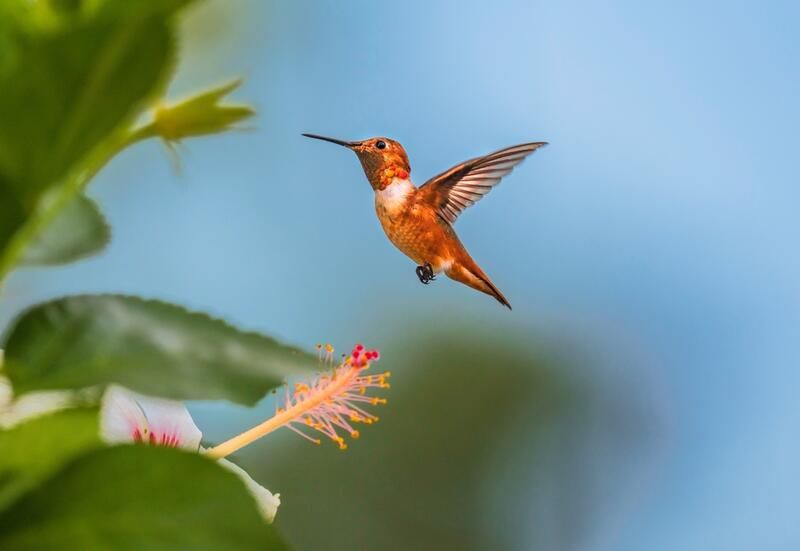
Hummingbirds look like fanciful beings that have somehow managed to find their way into the real world.


The tiny birds, which normally weigh less than a marshmallow, are capable of astounding feats of flight, including turning on a dime, flying backward, and zipping through the air at speeds of up to 50 mph.
A group of hummingbirds is called a "charm" so it's no wonder why people would wish to draw them to their yards.
If you want to attract small winged wonders, you need to make your garden a hummingbird sanctuary.
Read on to learn about some of the best ways to entice hummingbirds to your yard, including how to feed them and what to plant.
Just a spoonful of sugar
Hummingbirds need a ton of energy to survive due to their high metabolic rates.
Many garden owners use nectar feeders to attract these flashy fliers.
Although some shops sell hummingbird nectar, you can easily make your own by mixing a solution that is 4 parts water and 1 part white sugar.
A good tip is to remove impurities by boiling the mixture to extend its life.
Additionally, don't include any honey, red food coloring, or other additives while feeding hummingbirds.
Simple sugar and water are effective at attracting hummingbirds.
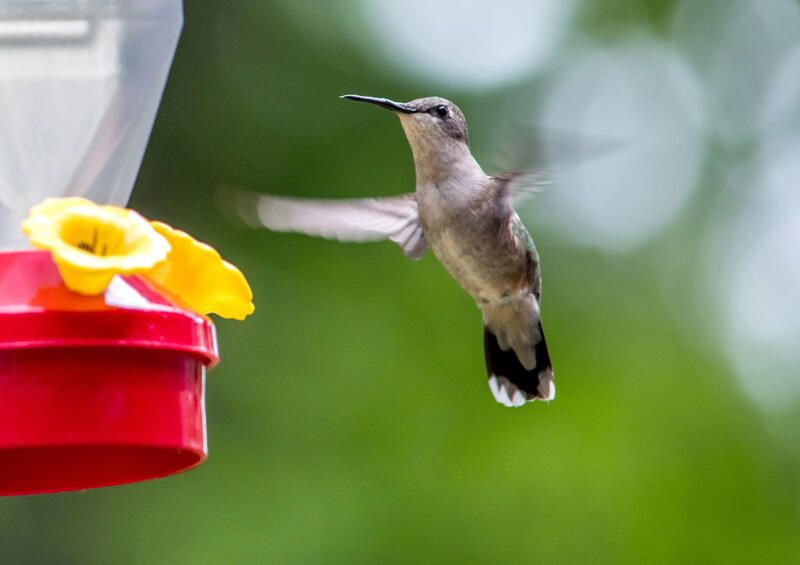
Don't add artificial ingredients to the nectar!
Although you may be tempted to get creative with nectar recipes, a hummingbird feeder should not be filled with anything other than hummingbird-friendly nectar.
This means it shouldn’t contain honey or other artificial sweeteners of any kind.
These kinds of artificial ingredients can be hazardous to hummingbirds’ delicate digestive systems and do some serious damage.
Just stick to the sugar and water. Trust us on this one.
Go red to attract hummingbirds
Hummingbirds are attracted to red naturally.
This is why the majority of nectar feeders you see have a red base or top to increase their luck attracting hummingbirds.
Make sure yours does, too.
To initially draw hummingbirds, some individuals may hang red ribbons, streamers, or tape throughout their yards.
As a result, the birds are encouraged to investigate and, hopefully, find the feeder filled with delicious sugar water.
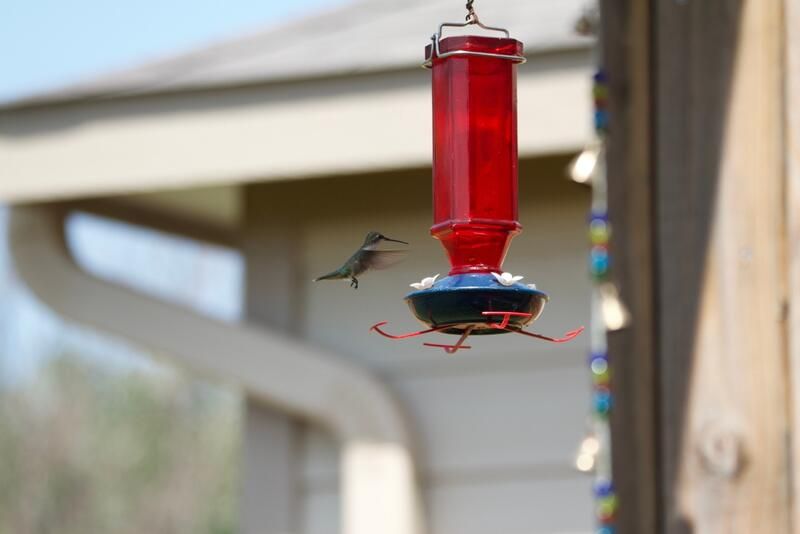
Do not put red dye in the nectar
Studies suggest that consuming red dye may have unforeseen negative effects on hummingbird health.
Furthermore, hummingbirds can be attracted without the use of red dye in nectar. Just ensure that the nectar feeder you use has a red top or base.
Keep your feeders clean and cool
Shade and Temperature are the two variables that will dictate how long nectar will last before it begins to ferment.
Try to keep feeders away from the sun.
You'll need to change the sugar water more frequently if the nectar is left to bake in the sun all day.
Nectar spoils most quickly in hot and humid climates.
So make sure to change it at least once every two days in the summer.
In cooler climates, you can get away with changing it once a week.
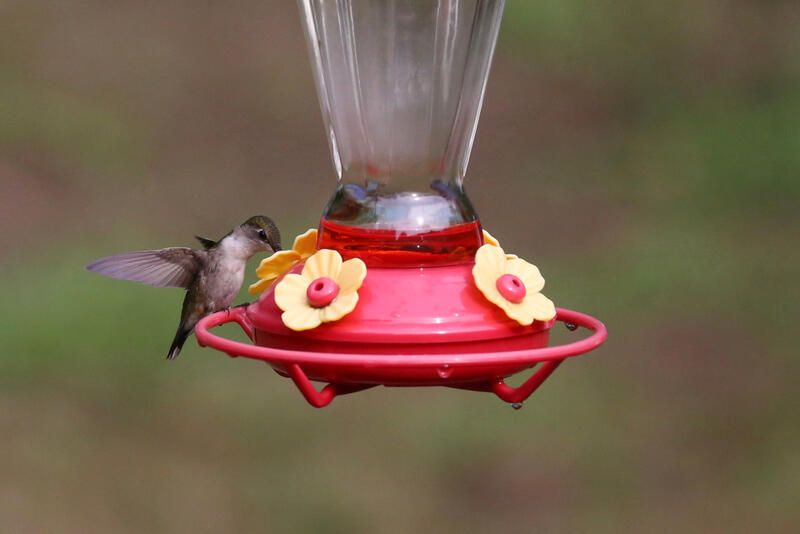
Keep your feeders stocked
Hummingbirds love routine.
Once they have located a dependable nectar source, they will revisit time and again until it runs out.
If you want your fluffy friends to make your home a regular haunt, make sure to keep your feeders full of tasty nectar at all times and never let them run dry!
Hang more than one feeder
Hummingbirds are very territorial birds and are very aggressive when faced with competition.
Once a hummingbird has located a feeder, it will try to scare off others and bully them out of its territory to keep all the nectar to itself.
To make your garden a hummingbird community rather than a table for one, hang multiple feeders, as many as you can to attract a host of the winged creatures.
Plant lots of their favorite flowers
One of the best ways to draw hummingbirds to your garden is to plant plenty of bird-friendly native plants.
Include lots of their favorite flowering plants from trees to shrubs to flowers.
The typical hummingbird will visit up to 2,000 flowers daily in search of nectar!
Designing a garden that is full of their favorite blooms is a surefire way to attract them.
Another bonus of having a luscious flower garden is that flowers are constantly serving up nature’s nectar.
This means if you take care of the flowers, the flowers will take care of the nectar themselves.
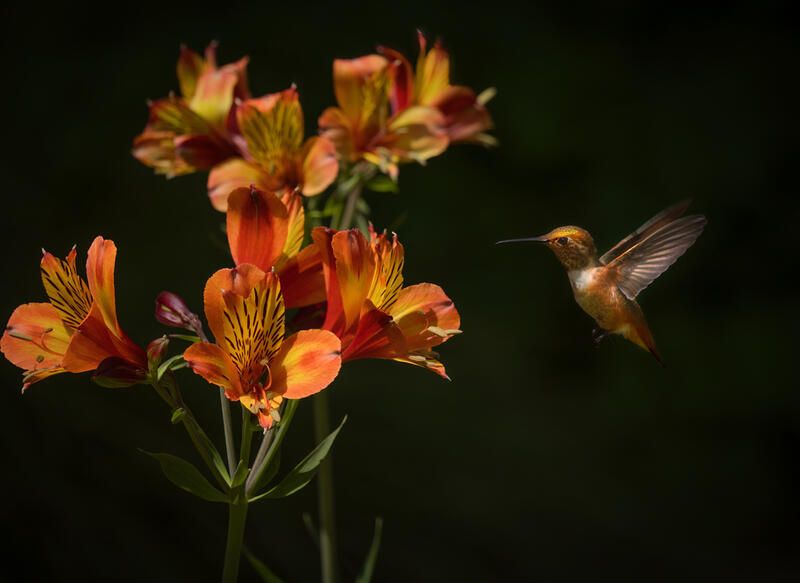
Cultivate native plants
Hummingbirds enjoy a healthy diet of insects and arthropods.
Native plants do a wonderful job of attracting all kinds of these tasty little critters, so make sure to include them in your garden plan.
Choose flowers that bloom at different times
Flowers of different species typically have different bloom times.
Include a variety of species that will bloom at different times of year to keep your yard hummingbird-friendly year round, not just when your Rhododendrons are blooming in spring.
It can be frustrating and time-consuming to try to filter among hundreds of potential blooms that hummingbirds may or may not appreciate.
Below is a list of flowering plants that have proven to be hummer favorites:
Bee Balm
The common Bee balm is a tiny perennial flower.
They are popular with hummingbirds, bees, and butterflies alike who come to them for nectar.
Nearly the entire continent of North America is home to some native species of bee balm.
There are over 50 commercially available variants of this flower with a variety of bright and beautiful colors.
Before selecting one, make sure to check its hardiness zone and do your homework, because some are mildew resistant and some will bloom better in your area than others.
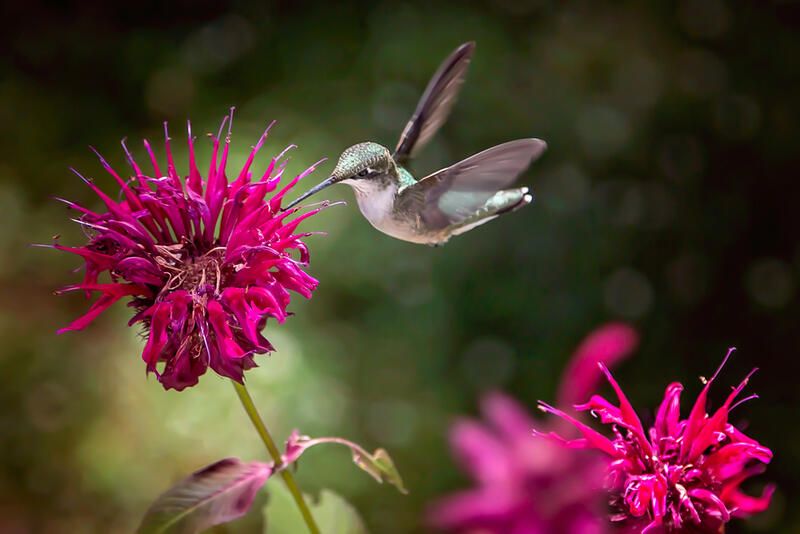
Sage
Sage, a.k.a. the Salva genus, is a wonderful plant that offers several advantages.
It is easy to maintain, looks stunning, and is extremely effective at attracting hummingbirds.
There are hundreds of various Sage species and cultivars that flourish in hummingbird gardens around the country.
As a result of this, it may be difficult to provide too many details regarding which species of Sage flower would perform best in your backyard.
Sage comes in a variety of colors and shapes.
Some are perennial while others are seasonal.
Although several of the species of Common Sage are indigenous to the Americas, the majority are native to the Mediterranean.
Given its extensive distribution, it is recognized as naturalized in North America.
So do your research and include a few of these fragrant flowers in your yard to make it just that bit more irresistible to birds flying past.
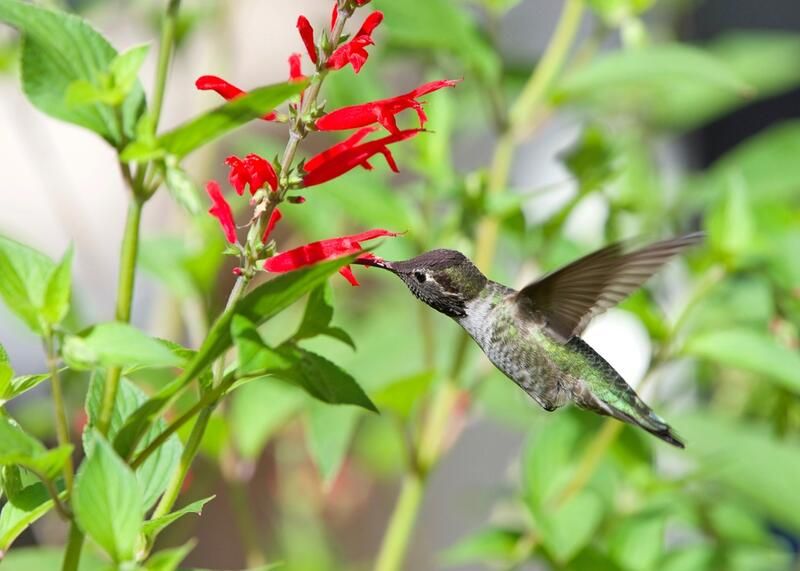
Tubular-shaped flowers are a hummingbird favorite
Hummingbirds are most drawn to long, tubular blooms like the Red Cardinal Flower, Honeysuckle, and aptly named Trumpet Vine.
This is because these kinds of flowers tend to have high amounts of nectar.
Secondly, their long tubular shape tends to deter insects from raiding them for nectar.
Hummingbirds, on the other hand, have no trouble reaching in with their long beaks.
Prune dying flowers
The real purpose of a flower (apart from looking pretty), is to attract pollinators, produce seeds, and survive as a species.
Once a plant has produced an ample amount of flowers, it will stop pollinating new ones.
As far as a hummingbird is concerned a plant that has ceased to flower is useless.
To the birds, a flower in bloom indicates a rich source of nutritious nectar, so no flowers, no food!
Fortunately, there is a way to encourage plants to flower by cutting the deadheads off.
This will stimulate the plant to bloom again and continue the cycle.
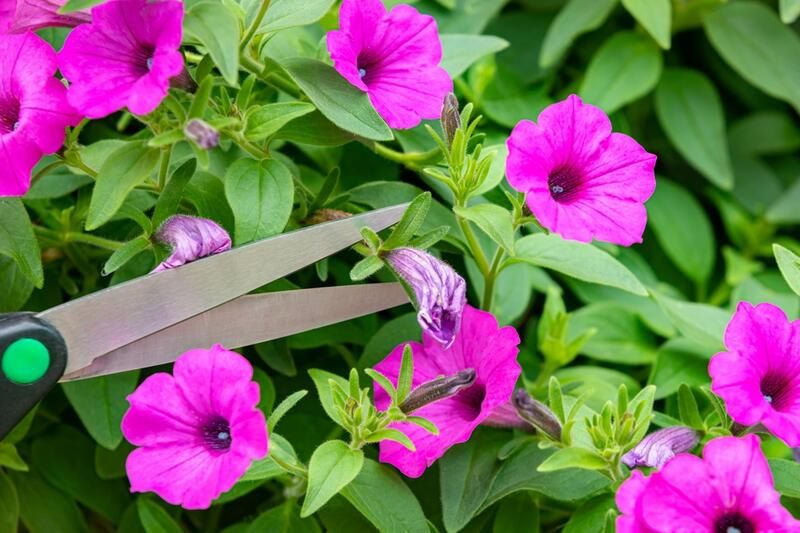
Be smart with locations
Don’t just randomly scatter hummingbird feeders around your yard.
Consider the following things when choosing where to install your feeders.
Place your feeder close to areas where flowers are already in bloom.
Try not to install your feeding posts in exposed areas.
Hummingbirds don’t feel safe feeding out in the open where they are vulnerable to predators.
Instead, place them under trees or other plants that provide cover.
In plain sight.
Although you don’t want predators to be able to see them, make sure to place the feeders somewhere that is visible to you!
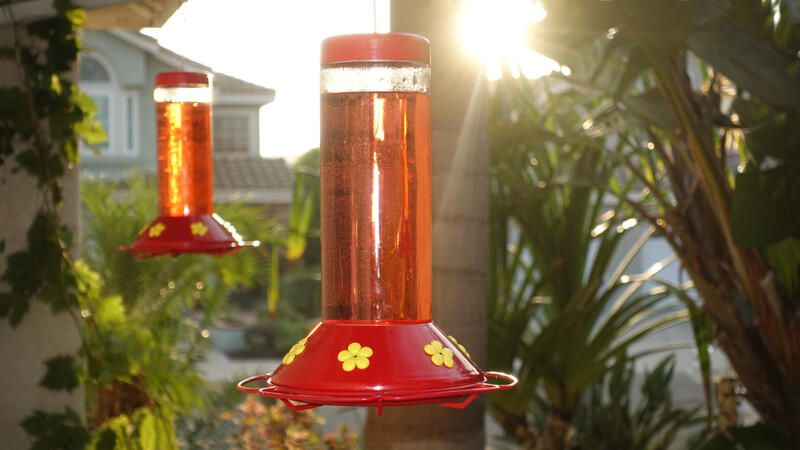
Prevent your hummingbird feeder from turning into a “yellow jacket” feeder
Plenty of creatures will be attracted to your nectar feast.
Bees, wasps, and hornets all love a good sweet dish, and they can easily turn your hummingbird feeder into a “yellow jacket” feeder if you are not careful.
Ward off bees with a deep dish design.
As with the tubular flowers, a deep dish is hard to reach for a small winged insect, whereas hummingbirds face no trouble reaching the sweet drink.
Take all precautions to ensure that your feeder doesn’t leak.
Any nectar that has dripped onto the ground is bound to attract a host of creepy crawlies, not to mention wasps once it evaporates in the summer heat.


